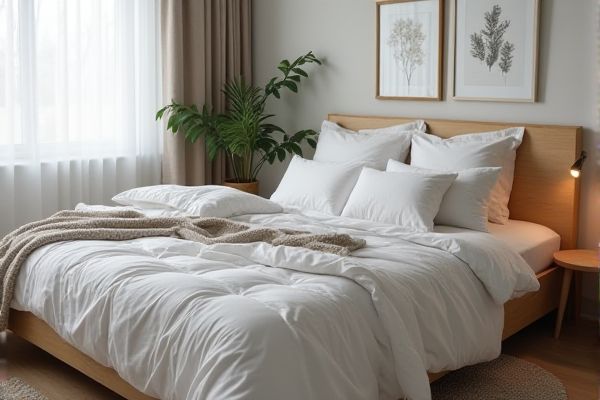
A duvet typically consists of a soft flat bag filled with down, feathers, wool, or synthetic fibers and requires a removable, washable cover, making it easy to clean and customize. Understanding the differences between a duvet and a comforter can help you choose the best bedding option for Your comfort and style preferences--read on to discover which suits Your bedroom needs.
Table of Comparison
| Feature | Duvet | Comforter |
|---|---|---|
| Definition | A soft flat bag filled with down, feathers, wool, or synthetic fibers. | A thick, quilted blanket filled with synthetic fibers or down. |
| Cover | Requires a removable duvet cover. | Typically used without a cover, often decorative. |
| Maintenance | Easy to clean by removing cover; duvet itself less frequent washing. | Needs whole comforter washing; more cumbersome to clean. |
| Warmth | Adjustable warmth by changing duvet inserts or covers. | Fixed warmth level based on filling. |
| Style | Versatile with interchangeable covers. | Less versatile; style fixed by design. |
| Lifespan | Long-lasting when properly maintained. | May wear out faster due to integrated design. |
| Cost | Higher initial cost, covers sold separately. | Generally lower cost, all-in-one product. |
Introduction to Duvets and Comforters
Duvets consist of a soft flat bag filled with down, feathers, wool, or synthetic fibers, designed to be inserted into a removable and washable cover, providing versatility and easy maintenance. Comforters are thick, quilted blankets filled with materials such as polyester or down, stitched to keep the filling evenly distributed, and intended to be used without a cover. Bedding preferences often depend on climate, care routine, and desired warmth, with duvets offering customization through covers and comforters providing an all-in-one solution.
What is a Duvet?
A duvet is a soft, flat bag filled with down, feathers, wool, or synthetic fibers, designed to provide warmth and comfort as a bedding layer. It requires a removable, washable cover called a duvet cover, which protects the duvet and allows easy customization of your bedroom style. Unlike comforters, duvets are versatile in maintenance and appearance, making them a popular choice for adaptable and hygienic bedding solutions.
What is a Comforter?
A comforter is a thick, quilted blanket filled with synthetic fibers or down, designed to provide warmth and insulation on a bed. It is typically stitched or quilted to keep the filling evenly distributed and often comes in various colors and patterns to function as both bedding and decor. Unlike a duvet, a comforter is usually used without a cover, making it easy to change the look of a bedroom without needing additional layers.
Key Differences Between Duvet and Comforter
Duvets consist of a soft flat bag filled with down, feathers, wool, or synthetic fibers and require a removable cover, offering customizable warmth and easy cleaning. Comforters are thick, quilted blankets filled with polyester or down alternative that function as a standalone bed covering with a fixed outer fabric. Key differences include maintenance--duvets need washing covers regularly while comforters require full cleaning less often--and versatility, as duvet covers allow style changes without replacing the entire bedding.
Materials and Fill Types
Duvets typically feature a soft, removable cover filled with natural materials like down feathers, wool, or synthetic fibers for lightweight warmth and breathability. Comforters are often composed of a single piece filled with polyester or cotton blend batting, designed for durability and ease of maintenance. Your choice between a duvet and a comforter depends on preferences for fill type, texture, and cleaning convenience.
Warmth and Insulation Comparison
Duvets typically offer superior warmth and insulation due to their high-fill power down or synthetic inserts that trap heat efficiently. Comforters generally have a thinner fill and rely on their outer fabric for warmth, making them less insulating than duvets. Your choice depends on desired warmth level and ease of maintenance, with duvets providing customizable insulation through interchangeable inserts.
Ease of Care and Maintenance
Duvets offer greater ease of care and maintenance because their removable covers are machine washable, allowing for regular cleaning without washing the entire insert. Comforters typically require more effort since the entire piece needs washing, which can be bulky and time-consuming, often necessitating professional cleaning. The practicality of duvet covers also enables quick style changes and ensures better hygiene with less hassle compared to comforters.
Design and Aesthetic Options
Duvets feature a minimalist, versatile design with removable covers that allow you to easily switch patterns and colors to match your bedroom decor, offering endless aesthetic customization. Comforters come pre-stuffed with filling and have fixed designs, often showcasing quilted patterns and stitched details that add texture and visual interest to your bedding. Choosing between a duvet and a comforter depends on your preference for adaptable style or ready-made decorative appeal in your sleep space.
Cost and Value Analysis
Duvets typically offer greater long-term value due to their reusable covers that are easy to clean and can change your bedroom's style without replacing the entire bedding. Comforters often come as a single unit, making initial costs lower but potentially less economical over time because they must be fully replaced when worn or dirty. When budgeting for bedding, consider the durability and flexibility of a duvet set for a more cost-effective and customizable sleeping experience.
Which is Better: Duvet or Comforter?
Choosing between a duvet and comforter depends on your preferences for warmth, maintenance, and style flexibility. Duvets provide customizable warmth with removable covers that are easy to wash, making them ideal for those who want versatility and convenience. Your decision should factor in cleaning habits and decor changes, as comforters often offer fixed style and require more effort to launder.
 homyna.com
homyna.com